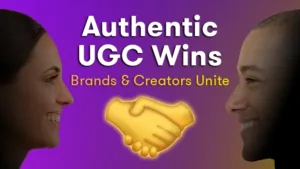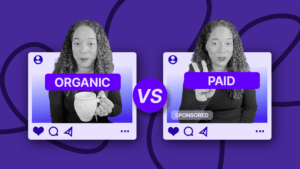Brands Looking for UGC Creators: Nailing Authentic Content
With over 7 years of e-commerce experience, Agne has mastered the balance of creativity and performance. From guiding social media strategies to crafting high-converting ads, she’s all about results.

User-generated content (UGC) is a marketer’s dream. It’s inexpensive, authentic, and taps into a wider audience.
But it is also attractive to creators. Brands will often pay top dollar for content promoting their products and services. UGC can drive sales and boost conversions, turning social media personalities into marketing machines.
Brands looking for UGC creators can leverage these people and generate social proof. If prospects see their peers recommending a product or service, they are likely to purchase it.
Therefore, this post is for you, whether you are a brand or a creator. It looks at why UGC creators are so advantageous and the types of brands already using them. You’ll get examples of partnerships already working and why they are so wildly effective.
Why Are Brands Looking for UGC Creators
Today, brands are fighting a tough battle for supremacy in the online space. But UGC could give some companies a way to get ahead.
UGC isn’t just a marketing buzzword – it’s an essential component of the buyer’s journey. It can play a role in every sales funnel stage, from awareness to conversion to repeat business.
For starters, brands that work with UGC creators can often lower their marketing outgoings substantially. Instead of hiring professionals, they get customers, ambassadors, and the public to do it for them.
Secondly, UGC boosts credibility and trust. Prospects and leads are more likely to take their peers (i.e. other customers) seriously than brands using slick corporate ads.
UGC may also improve customer relationships. Ambassadors and peers can often forge closer bonds with their audiences, building stronger ties with their company and what they sell.
The SEO benefits of this process can be considerable. Google and other platforms love review content and use it to establish brand authority and credibility. Companies with more positive and five-star reviews could see their Google Business Profiles soar compared to their competitors.
Lastly, diversity may play a significant role for some brands (as discussed below). UGC enables firms to reach out to prospects with anyone willing to be an ambassador for their products and services. Creators across the spectrum can cut through racial, religious, ethnic, gender, and sexuality lines.
What Types of Brands Seek UGC Creators?

UGC creators are still quite a new concept. However, they can benefit companies operating in almost every industry.
E-Commerce Brands
For example, UGC creators can be a fantastic addition to ecommerce brands. Businesses often use them for reviews or to supply product images (which help testimonial content rank higher on sites like Amazon and Etsy).
Many retailers rely on this content to make sales. Ecommerce stores need honest reviews from real product/service users who can build trust and credibility with their audiences.
Fitness And Wellness Brands
Fitness and wellness brands also need wellness creators. Companies like MyFitnessPal use them for tips and meal ideas, while Peloton employs them for success stories and motivation.
UGC creators aim to prove the benefits of long-term adherence to challenging programs. Companies in the fitness space can demonstrate their value by leveraging influential creators who’ve seen success.
Travel And Hospitality Brands
Travel and hospitality brands looking for UGC creators showcase the visual appeal of their vacations and destinations. Content is usually inspirational, focusing on expert photography.
Furthermore, many UGC creators are willing to supply photos, videos, and content for vacation destinations they want to visit anyone. These introduce leads to new cultures and stories, getting prospects to imagine what they’d do on their trips.
Food And Drink Brands
Food and drink companies are also among the brands that need UGC creators. Like the travel and hospitality sector, they rely on strong visuals to appeal to their audiences.
Chipotle, Absolut Vodka, and Dunkin’ are all UGC creator brands that understand the value of getting people to share images and stories about their products online. Content often tempts customers to make impulse orders and gets them in the mood to try different types of food. It can also create a sense of community –some audiences like being associated with particular food or drink brands.
Tech Brands
Tech is another sector with brands looking for UGC creators. For example, GoPro famously worked with dozens of shoppers, getting them to post their adventure-themed content online, showing off the quality of its cameras and gimbals. Apple did something similar during product launches, leveraging customers to showcase their new devices in action, like the camera and video capabilities, instead of paying for professional tech demonstrations (which probably would have had less reach!)
Fashion Brands
Lastly, fashion brands also use UGC creators. Companies like Gymshark, Nike, and Adidas regularly get their customers to post themselves wearing their apparel on social media. They aim to create more impactful social proof (going beyond reviews) and use user audiences to drive more engagement and sales. As such, UGC is helpful for trendspotting. Working with numerous creators allows brands to see how people use their products and what they can change to generate more sales in the future.
How Brands Find UGC Creators (The Easy Way)
Finding UGC creators is more straightforward these days, thanks to the abundance of platforms available. But where should brands look specifically?
Social Media Platforms
The most obvious place for discovering UGC creators is social media platforms. These can be excellent places to find individuals aligning with brand messaging.
TikTok and Instagram are the most highly searchable (thanks to hashtags and search features). However, companies can also find creators on X if they look in the right niches or use the search bar.
Influencer Identification tools
If searching doesn’t work, brands could try using influencer identification tools. These leverage vast databases and AI to discover individual creators who might be a match. (Try HypeAuditor or Upfluence).
UGC Platforms And Marketplaces
UGC platforms and marketplaces are another place to look. These aggregate customer content contributions, and help identify people to work with at the grassroots. And FYI, we are such platform! Feel free to check our 5,000+ UGC creators here.
Some platforms also curate UCG from various sources and display it on product or service pages. This lets companies add social proof to their products and services pages more easily.
So-called “content marketplaces” are also available. These often host user-generated images and videos that aren’t stock. Many are “handmade” and crafted for specific niches (but don’t offer much social proof).
Community Groups
Sometimes, firms approach UGC creators on community forums like Reddit, Quora, and Facebook groups. If a commenter is willing to talk about a brand (or write an extensive piece about what they do), they usually agree to work with the company or share its content.
Because of this, UGC is sometimes paid. However, highly engaged and active individuals will often provide a free first round of posting.
Influencer Agencies
Talent or influencer agencies to find people willing to talk about or promote products are another option. These organizations collect influencers in various categories and make outsourcing campaigns simpler.
Look For Users Engaging With Your Rivals
Lastly, if that doesn’t work, companies can join brand conversations involving their competitors and watch out for contributors. Highly engaged people who contribute regularly are the most likely to form partnerships.
If these individuals love the company’s products/services, they often become staunch brand advocates, particularly if they move away from a rival.
How To Collaborate In Style: 8 Top Tips
Here are some collaboration tips for brands:
- Look at creators content and if it makes sense to use them for your brand
- Check their engagement levels (and whether working with them is worthwhile)
- Tell UGC creators what you want by outlining “deliverables” (the standard of content you expect)
- Inform influencers about your brand and what you want to achieve (getting “buy-in” helps generate better content)
- Outline a clear offer (tell them what they get and what you want in return)
- Write them a personal letter or email (especially if they have a lot of followers)
- Provide enough cash to make it worth their while
- Keep tracking the performance of your UGC content to see what works best.
Successful UGC Collaborations: What Got Audiences Pumped?
So that’s the theory out of the way. But what do successful brand-creator partnerships look like in practice?
This section runs through case studies from the past and what they can teach us.
Otterbox
On the surface of it, Otterbox seems like a run-of-the-mill smartphone case company. The protective gear for expensive handsets looks almost identical to any other brand.
However, the outfit goes beyond most labels by passing the responsibility of testing its phones to its audience. Otterbox isn’t afraid to risk allowing customers to push its concepts to the limit on their social channels unsupervised and post the results.
Why it worked:
Only Otterbox is willing to put its products to the test in uncontrolled situations, generating tremendous social proof. As such, the campaign generated massive trust, encouraging thousands of people to place orders within days of the campaign going live.
Meshki
Meshki is a women’s fashion brand that makes dresses and fashionable accessories. The company, based in Australia, aims to make women feel confident and empowered.
Consequently, the brand recently put a call out on TikTok and X for UGC creators to post trending fashion content involving its clothing like their boyfriends buying clothes from the brand.
Why it worked:
The campaign was a masterclass in grabbing attention on social media at low cost. Creators shared the brand’s products with their audiences, gaining new interest overnight.
Patagonia
Patagonia is an outdoor clothing brand known for its commitment to the natural world. It offers innovative schemes to reduce environmental harm, including repairing clothing instead of replacing it brand new.
Patagonia’s UGC scheme involved creators posting images of the brand’s products used outdoors in their natural habitat. Hikers, bikers, and kayakers shared pictures in far-flung locations showing how coats, gloves, and shoes helped them.
Why it worked:
Patagonia’s UGC campaign revealed the inherent strength and practicality of its products. Getting users to model them in various environments showed the real-life practicality they offered.
Burt’s Bees
Burt’s Bees is a much-loved skincare brand, focusing on all-natural ingredients and wellness. The company regularly works with beauty bloggers and lifestyle gurus to promote its products to their audiences.
Why it worked:
Burt’s Bees recognized the value of making their products more relatable. Getting familiar influencers (but also real people) to discuss and use their creations allowed them to connect to their audiences better. As such, the company was able to better position itself in a crowded marketplace and stand out more than other offerings.
How Billo Is Using UGC To Help Brands
Billo has some success stories of its own.
For instance, Billo helped:
- Lime&Lou to create UGC video ads that increased click-through-rates by 15%
- Pineapple Products to boost customer engagement and increase ROI by a whopping 10.75%
- Adore Me to expand its creative output with 15% higher click-through-rates versus the brand’s non-Billo ads
- Intelligent Media to increase return on advertising spending by 14.5%
What’s Next For UGC?
The number of brands looking for UGC creators is expanding. Already, 87% of companies are using UGC in some form to share their audience.
But given this rapid progress, what comes next? And how will UGC’s marketing strategies change?
USC collaboration will likely involve more AI going forward. Artificial intelligence will help identify creators within the noise and chatter on social media, and it may even take over some content generation (if it looks natural).
Brands will also likely focus more on established (but small-scale) micro- and nano-influencers. These have small, highly engaged audiences, enabling better content targeting (which is better for creators and brands alike).
Live Streaming is another trend. More UGC creators will aim to give their content more “rawness” by creating it in real-time, instead of recording and editing first.
Lastly, expect to see more focus on eco-friendly initiatives as target audiences become more planet-aware. Many UGC campaigns will likely focus on corporate social responsibility, working to convince audiences that businesses are behaving ethically.
How The Role of UGC Creators in Marketing Strategies Will Evolve
UGC creators will likely become more active in co-creating content with brands. The two may forge closer ties, enabling companies to get closer to their desired deliverables without stifling influencers’ creative freedom.
Diversity will also matter more. Companies will want faces from every background to represent them, targeting every niche in their audience.
Looking to start your UGC journey today?
Join Billo as a creator or as a brand today
Continue learning:
Creative Manager
With over 7 years of e-commerce experience, Agne has mastered the balance of creativity and performance. From guiding social media strategies to crafting high-converting ads, she’s all about results.

Authentic creator videos, powered by real performance data
22,000+ brands use Billo to turn UGC into high-ROAS video ads.
Common UGC Brief Mistakes Brands Still Make in...
A vague or overpacked brief derails campaigns before they start, [...]...
Read full articleOrganic UGC vs Paid UGC: How Top Brands Drive Gr...
More brands are turning to user-generated content (UGC) to fuel [...]...
Read full articleOrganic UGC: How to Turn Native Creator Posts in...
Short-form feeds spotlight content that feels natural, not like ads. [...]...
Read full article



